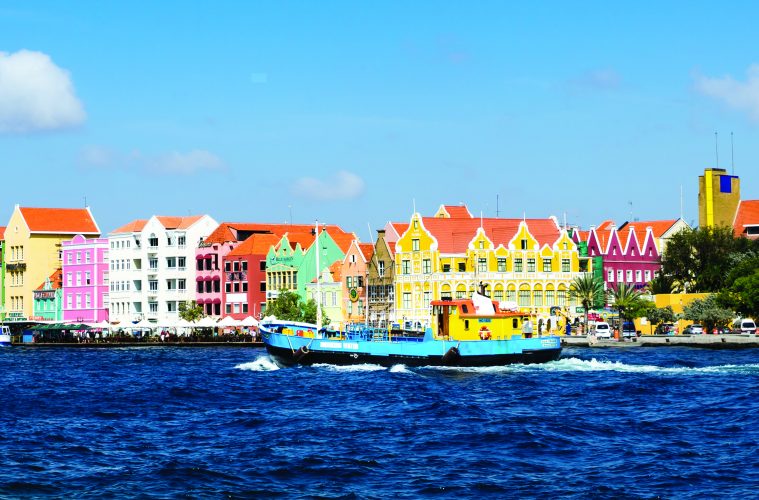Here is what you will see as you drive from one end of Curaçao to the other: the beach, forests of 15-foot cacti lining both sides of the road, the beach, 50-something flamingos wading in the shallow green water of the Jan Kok salt flats. And then, the beach.
Drive in any direction for more than a few minutes and you’re sure to hit one of the island’s semiprivate paradises. Perhaps it’s because the Beach Boys never learned how to pronounce the country’s name (“Kewr-e-sow”), but tourism has only recently broken into the top spot on the country’s list of largest industries, and there’s still plenty of room to stretch out in the sand.
On our first day, our guide takes us to the island’s west side, home to some of the best (and most secluded) beaches, including Playa Knip, a pretty strip of sand dotted with thatch umbrellas, surrounded by rugged terrain, and looking out on turquoise water so clear that it appears lit from beneath somehow. I track down the teenaged boy renting out snorkeling equipment and hand him $10 (the official currency is the guilder, but dollars are accepted everywhere), and then I begin flippering my way to the small coral reef on the far side of the beach.
The next day, I tour downtown Willemstadt, the capital city and site of the island’s most famous image—a cluster of colorful colonial buildings lining the Santa Anna Bay. Here, I learn the story of how nearly all of Curaçao’s structures ended up painted in vibrant blues or pastel pinks or electric teals. The tale sounds to my ears more like legend than history, but our guide swears it’s true. Once upon a time, the buildings were all white, but the Dutch governor of the island claimed that the glare from the sun was giving him headaches and ordered that they all be painted. Years later, it was discovered that the man also had a significant stake in the island’s sole paint company.
We spend some time at the floating market, where fishermen sell their catch dockside, and then pop inside the canary-yellow Mikvé Israel-Emanuel Synagogue, the oldest synagogue in the Americas. We’re given several explanations for the temple’s sand floor, one of which is that it recalls the Jewish people’s 40-year exile in the desert.
On our third day, it’s back to the beach. This time we go to Jan Thiel, where the vibe is more upbeat than laid-back, with strangers chatting over piña coladas and Amstel Brights at the resort’s beach bars, and families kicking soccer balls back and forth. I rent snorkeling gear again, and am promised a glimpse of a sunken ship, but the chop here is too much for me, so I sit in a lounge chair and watch European tourists attempt to balance on a “flyboard”—a water-powered jetpack that looks more novel than fun.
Normally, I’m not much of a sun worshipper, but my trip to Curaçao comes just before the long, slow descent into the dark of New England fall and winter, so the next morning, in the hours before our flight is set to leave, we arrange to go to the beach one last time. As our ride sets out, I wonder whether it’s worth the visit. It’s drizzled rain all morning (the first bad weather of the trip), and the sky is cloudy as we make our way to Mambo Beach.
When we arrive, though, the clouds have parted. Even better, they’ve scared off whatever other bathers there might be on a Sunday morning, and we have the water almost completely to ourselves. A breakwater stretches the entire length of the quarter-mile beach; beyond it, the sea is dark blue and dotted with whitecaps, but inside the barrier, the waters are still and clear. I slather myself with sunscreen and head in for one last swim.
By the time I leave, the beach is beginning to fill in a bit. It can’t stay empty forever. But for now, for this moment, it’s just me and the whispering waves.

